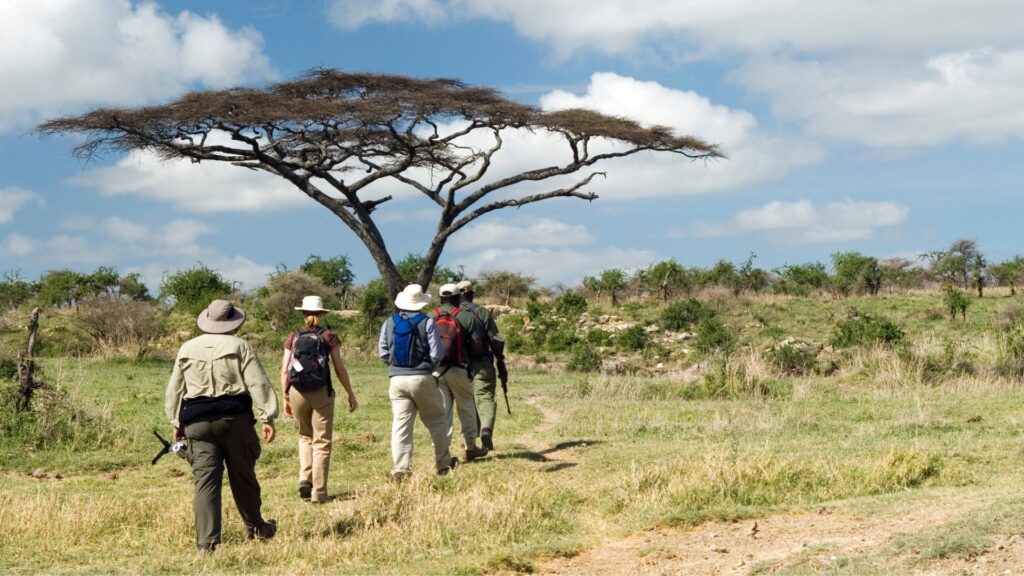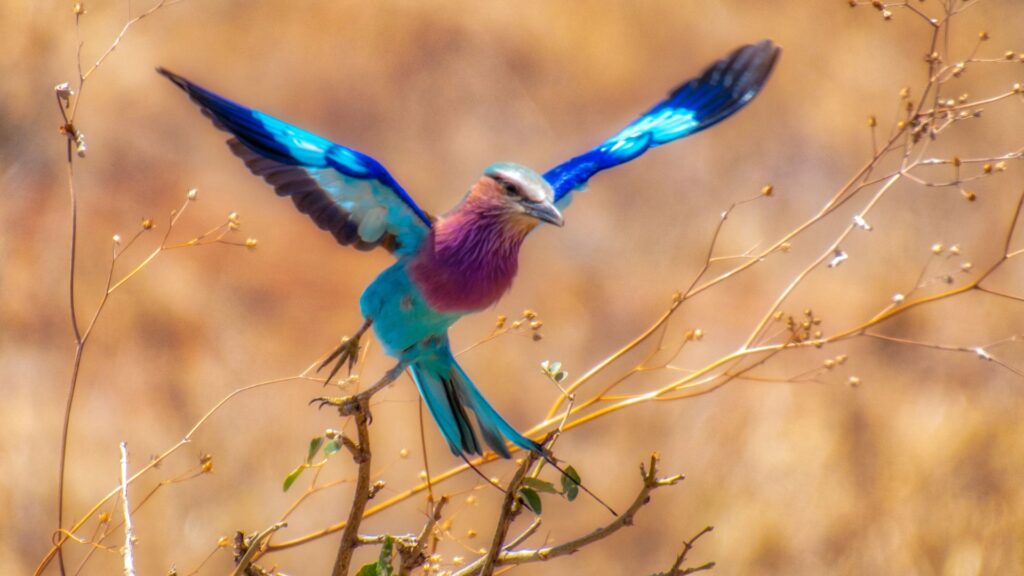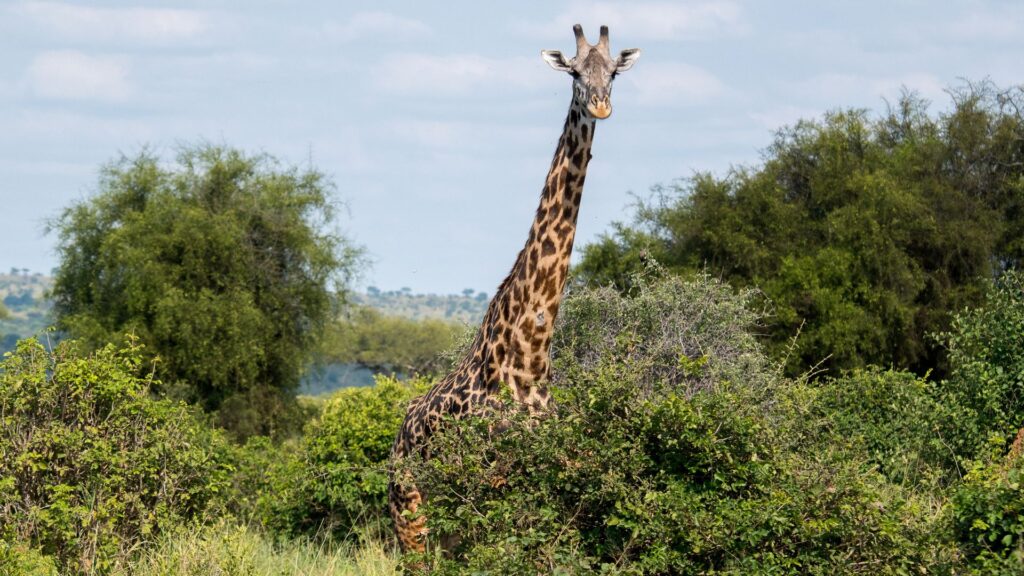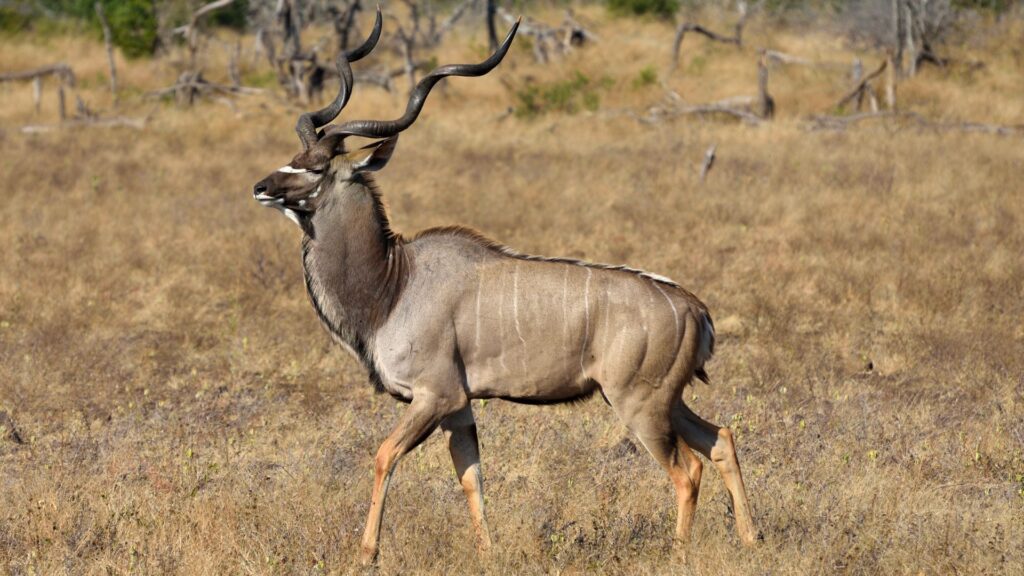Tanzania Walking Safaris
Tanzania Walking Safaris
Introduction
Tanzania is world-renowned for its diverse safari options, offering travelers unforgettable wildlife experiences in iconic parks like Serengeti, Ngorongoro, and Tarangire. From game drives to hot air balloon rides, Tanzania’s landscapes are teeming with abundant wildlife, making it a premier destination for safari enthusiasts. While vehicle-based safaris offer excellent opportunities for wildlife viewing, walking safaris provide a more immersive and intimate connection with nature.
Walking safaris allow adventurers to step into the wild, experiencing the thrill of tracking animals on foot and engaging with the environment in a way that can’t be replicated from a vehicle. Led by skilled guides, walking safaris take travelers closer to the natural world, highlighting the smaller details of the ecosystem while offering the chance to encounter wildlife up close. As the demand for more authentic and adventurous experiences grows, walking safaris are becoming increasingly popular among those seeking to experience Tanzania’s wilderness from a fresh perspective.

What is a Walking Safari?
A walking safari is a unique and exhilarating way to explore the African bush on foot, led by experienced guides who are knowledgeable about the wildlife and the ecosystem. Unlike traditional vehicle-based safaris, walking safaris allow you to connect more deeply with nature as you move quietly through the environment, focusing on the smaller details of the wilderness. Instead of simply observing animals from a distance, you have the chance to follow tracks, learn about plants, insects, and smaller creatures, and engage with the raw beauty of Tanzania’s landscapes in a personal and interactive way.
The pace of a walking safari is slower and more serene than a game drive, allowing for a heightened awareness of your surroundings. This slower tempo offers a greater appreciation for the sounds, sights, and smells of the bush that often go unnoticed from a vehicle. Walking brings you closer to wildlife, though from a safe distance, providing a thrilling sense of being in the animals’ territory without disturbing their natural behavior.
Guided safaris with armed rangers are crucial for safety. These rangers are trained to anticipate animal behavior, track wildlife, and ensure the safety of the group while minimizing risks. Their expertise allows you to enjoy the thrill of the wild while adhering to strict safety protocols, making walking safaris both adventurous and secure.

Popular Destinations for Walking Safaris in Tanzania
Selous Game Reserve (now part of Nyerere National Park)
Known for its vast, wild, and untamed landscapes, Nyerere National Park offers some of the most authentic walking safari experiences in Tanzania. As one of the largest wildlife reserves in Africa, it is home to diverse wildlife, including lions, elephants, giraffes, and buffaloes. The park’s remote nature and fewer tourists make it an ideal destination for adventurous travelers seeking to explore untouched wilderness on foot.
Ruaha National Park
Ruaha National Park is perfect for those looking for remote, off-the-beaten-path walking safari experiences. The park’s rugged landscapes, baobab-dotted plains, and winding rivers provide an impressive backdrop as you walk through the wild. Ruaha is known for its large populations of elephants, lions, and other big game, as well as its birdlife, making it a top choice for wildlife enthusiasts looking to explore on foot.
Tarangire National Park
Famous for its large herds of elephants and its diverse landscapes, Tarangire National Park offers excellent walking safaris where you can explore open savannahs, woodlands, and swamps. With opportunities to encounter animals like zebras, wildebeests, and even leopards, Tarangire’s varied environment makes it a compelling destination for walking safaris. Its proximity to other Northern Circuit parks also makes it an accessible option.
Ngorongoro Conservation Area
Walking safaris in the Ngorongoro Conservation Area provide a unique chance to experience the stunning beauty of the crater and its surroundings on foot. You can explore the crater rim, as well as the highland forests, and visit traditional Maasai villages. The conservation area is rich in wildlife, and walking through it offers an intimate experience with the diverse ecosystems, including sightings of animals like buffalos, gazelles, and even the occasional predator.
Arusha National Park
For those looking for a shorter, scenic walking safari, Arusha National Park is an excellent choice. The park is easily accessible from Arusha town and offers beautiful views of Mt. Meru and diverse habitats, from savannahs to rainforests. Walking safaris here provide opportunities to see giraffes, zebras, and bushbucks, along with a variety of bird species. Its accessibility makes it a great option for day trips or shorter safari experiences
What to Expect on a Walking Safari
Pace and Duration
A walking safari typically lasts between 2 to 4 hours, covering shorter distances than game drives but offering a more intimate connection with the environment. The pace is relaxed, allowing participants to fully absorb their surroundings and focus on the finer details of the bush. Unlike a vehicle-based safari, where covering large distances quickly is possible, walking safaris focus on immersing travelers in the landscape, giving time to appreciate the smaller aspects of nature.
Wildlife Sightings
While the focus of a walking safari isn’t always on spotting big game, it provides a unique opportunity to observe smaller creatures and the intricate workings of the ecosystem. Guides will help you track animals by identifying footprints, dung, and other signs, as well as introducing you to the fascinating world of insects, birds, and plants. Learning to read the landscape and understand the subtle clues left behind by animals adds a different layer to the safari experience.
Close Encounters
Walking safaris offer the potential for more intimate encounters with large mammals, although from a safe distance. You may encounter animals like giraffes, zebras, or elephants, offering a thrilling sense of being in their territory without the barrier of a vehicle. However, guides maintain a cautious approach to ensure the safety of both visitors and wildlife, ensuring that these encounters remain respectful and non-intrusive.
Learning Experience
One of the key aspects of a walking safari is the educational component provided by experienced guides. Guides offer detailed explanations of animal behavior, survival tactics, plant life, and the ecological balance of the environment. This deeper level of engagement turns the safari into a learning adventure, helping participants develop a greater appreciation for the complexities of the wilderness and the animals that inhabit it.
Safety on Walking Safaris
Overview of Safety Measures
Walking safaris in Tanzania are led by highly trained professional guides, often accompanied by armed rangers, to ensure the safety of participants. These guides possess in-depth knowledge of the environment, animal behavior, and tracking skills, which are crucial for keeping the group safe while exploring the bush on foot. The presence of armed rangers provides an extra layer of security, particularly in areas with larger predators like lions, elephants, or buffaloes.
How Guides Keep Groups Safe
Safety on walking safaris is maintained through the guides’ expertise in tracking and their keen situational awareness. They are skilled at reading animal tracks, understanding warning signs from wildlife, and anticipating potential danger long before it becomes a threat. Guides lead the group strategically, ensuring that everyone remains at a safe distance from animals while still providing close encounters that are thrilling yet secure. Their knowledge of animal behavior allows them to calmly navigate the group away from any potential risks without alarming the animals.
Following Instructions and Maintaining Silence
To ensure a safe and enjoyable experience, it is essential to follow the guide’s instructions at all times. Maintaining silence and moving slowly are crucial, as sudden movements or loud noises can disturb wildlife and provoke defensive behavior. By staying quiet and attentive, travelers not only increase their chances of seeing more animals but also ensure that they do not disturb the natural environment or put themselves at risk

Why Choose a Walking Safari?
Connection with Nature
Walking safaris offer a deeper, more personal connection with nature, allowing you to experience wildlife and landscapes up close without the barrier of a vehicle. The quiet, slow-paced exploration provides a more intimate interaction with the environment, as you become part of the surroundings rather than just an observer. Every sound, movement, and scent becomes more pronounced, immersing you fully in the wilderness and giving you a unique appreciation for the natural world.
Unique Experience
On a walking safari, the focus extends beyond big game, offering a rare opportunity to track animals, learn about plant life, and discover the smaller, often overlooked aspects of the ecosystem. You’ll be guided through the bush, identifying animal tracks, learning about survival tactics, and gaining insights into the intricate balance of life in the wild. This unique perspective provides a richer understanding of the environment and allows you to see things often missed during vehicle-based safaris.
Adventure and Thrill
Walking safaris are inherently adventurous and thrilling, providing a heightened sense of excitement as you explore the wild on foot. There’s an undeniable thrill in knowing that you’re sharing the same ground as some of Africa’s most iconic animals, with nothing but your senses and the guidance of skilled rangers to navigate the terrain. The direct engagement with the environment and the unpredictability of the experience make walking safaris a truly exhilarating way to explore Tanzania’s wilderness
Best Time for Walking Safaris in Tanzania
Ideal Seasons: Dry Season (June to October)
The best time for walking safaris in Tanzania is during the dry season, from June to October. During this period, wildlife is easier to spot as animals gather around water sources, and the vegetation is less dense, providing clearer views of the surroundings. The dry conditions also make walking more comfortable, with cooler temperatures and lower chances of rain disrupting your safari. Additionally, the dry season aligns with peak wildlife activity, making it an ideal time to encounter animals like elephants, giraffes, and predators on foot.
Impact of Weather Conditions
While walking safaris are most popular during the dry season, the wet seasons (March to May and November to December) also offer their own unique experiences. The landscape becomes lush and vibrant, with fresh vegetation and a burst of birdlife. However, the wet conditions can make some areas less accessible, and the dense foliage may make spotting wildlife more challenging. That said, the lower number of tourists during the wet season can create a more private, serene experience for those seeking a quieter adventure.

What to Bring for a Walking Safari
Clothing
When preparing for a walking safari, it’s essential to wear lightweight, breathable clothing in neutral colors like khaki, beige, or olive to blend into the natural environment. Avoid bright colors, which can attract unwanted attention from wildlife. Sturdy, comfortable walking shoes are a must for navigating rough terrain, and you should also bring a wide-brimmed hat, sunglasses, and sunscreen to protect yourself from the sun.
Gear
To enhance your walking safari experience, bring a good pair of binoculars for spotting wildlife at a distance and a camera with a telephoto lens to capture close-up shots of animals and landscapes. A small backpack to carry essentials like your water bottle and a camera is also recommended. Staying hydrated is crucial during the safari, so carrying your own water is important, especially in the dry season when temperatures can rise.
Health Considerations
For your health and comfort, staying hydrated is vital, especially during long walks in the sun. Insect repellent is another essential item, as you’ll be spending time in areas where mosquitoes and other insects are more active, particularly near water sources. Wearing long sleeves and trousers can also help protect against insect bites while keeping you cooler in the sun
Why Choose Us
Expert Guides
Guides ensure unforgettable, safe, and enriching experiences on every adventure.
Tailor-made Experience
Tailor-made experiences crafted to fulfill your unique desires and preferences.
Unique Bespoke Deals
Unique bespoke deals tailored to your preferences, creating unforgettable safari experiences.
Hassle Free Adventures
Hassle-free adventures: where every moment is an unforgettable journey.

Verified Chao MA team of professionals that I would recommend WilliamsomAdventures is a very recommendable Safari team, in the pre-consultation and confirmation of details William gave me the biggest feeling of professionalism and reliability. As I was travelling alone with my children on the safari, I was very satisfied with the safety and hassle-free experience throughout the trip, all the matters were just as William had arranged for us before departure, and all our requirements were greatly satisfied. Our guide, Ibra, was very professional on our safari and helped us to maximise our safari with safety in mind, we saw a lot of animals on our journey and he introduced us to many of them to help us understand the land better. Undoubtedly, my children and I were very impressed with this trip in July and I would gladly recommend them to friends who are interested in going Safari in Tanzania.Verified
Chao MA team of professionals that I would recommend WilliamsomAdventures is a very recommendable Safari team, in the pre-consultation and confirmation of details William gave me the biggest feeling of professionalism and reliability. As I was travelling alone with my children on the safari, I was very satisfied with the safety and hassle-free experience throughout the trip, all the matters were just as William had arranged for us before departure, and all our requirements were greatly satisfied. Our guide, Ibra, was very professional on our safari and helped us to maximise our safari with safety in mind, we saw a lot of animals on our journey and he introduced us to many of them to help us understand the land better. Undoubtedly, my children and I were very impressed with this trip in July and I would gladly recommend them to friends who are interested in going Safari in Tanzania.Verified jeff C7-Day LeMosho Route I'm thrilled with Williamson Adventures! My brother and I traveled from Canada and were initially quite nervous about trekking Mount Kilimanjaro. However, upon arriving in Moshi, all our nerves vanished. We were warmly welcomed at the hotel by William and one of our guides, who were incredibly friendly. The rest of the trip was fantastic! The guides, porters, and cooks were all amazing, and the food was delicious. The support and encouragement we received throughout exceeded our expectations. Planning the trip required some coordination, but William was always quick to respond and incredibly helpful. For example, he seamlessly arranged our pick-up from Nairobi to Moshi. He also organized an extra night at the hotel in Moshi and an airport shuttle, even though he didn't have to. This company truly goes above and beyond to make the experience unforgettable. We highly, highly recommend Williamson Adventures! Thanks to William, our guides Kevin and Yoeseff, and our amazing porters—the real superheroes!Verified
jeff C7-Day LeMosho Route I'm thrilled with Williamson Adventures! My brother and I traveled from Canada and were initially quite nervous about trekking Mount Kilimanjaro. However, upon arriving in Moshi, all our nerves vanished. We were warmly welcomed at the hotel by William and one of our guides, who were incredibly friendly. The rest of the trip was fantastic! The guides, porters, and cooks were all amazing, and the food was delicious. The support and encouragement we received throughout exceeded our expectations. Planning the trip required some coordination, but William was always quick to respond and incredibly helpful. For example, he seamlessly arranged our pick-up from Nairobi to Moshi. He also organized an extra night at the hotel in Moshi and an airport shuttle, even though he didn't have to. This company truly goes above and beyond to make the experience unforgettable. We highly, highly recommend Williamson Adventures! Thanks to William, our guides Kevin and Yoeseff, and our amazing porters—the real superheroes!Verified Xinyue QGreat Safari Experience Experienced guide, saw all of the great five. Communication is fast with quick response. The itinerary arrangement is reasonable and interesting. Despite some misunderstanding in the beginning, William was able to rearrange accommodation within short period of time. Helped to celebrate birthday of one friend during the trip, very unforgettable experience!!Verified
Xinyue QGreat Safari Experience Experienced guide, saw all of the great five. Communication is fast with quick response. The itinerary arrangement is reasonable and interesting. Despite some misunderstanding in the beginning, William was able to rearrange accommodation within short period of time. Helped to celebrate birthday of one friend during the trip, very unforgettable experience!!Verified Leon CLucky safari We came across Williamson Adventure by accident, and we also chose a few ground handlers to compare, and Williamson was the one with the fastest feedback and the best value for money in terms of combined quotes. Our team of 10 people unanimously gave them five stars, they provide the best service. The owner of Williamson was patient and meticulous in communicating with us beforehand and tried his best to meet our every request, and he also solved the problems we encountered during the safari, and even went to the airport to see us off before we finally left Arusha. We are very satisfied with Williamson's sincerity, and would like to recommend it to every friend who is interested in safari in Tanzania, it's really great and very thoughtful!Verified
Leon CLucky safari We came across Williamson Adventure by accident, and we also chose a few ground handlers to compare, and Williamson was the one with the fastest feedback and the best value for money in terms of combined quotes. Our team of 10 people unanimously gave them five stars, they provide the best service. The owner of Williamson was patient and meticulous in communicating with us beforehand and tried his best to meet our every request, and he also solved the problems we encountered during the safari, and even went to the airport to see us off before we finally left Arusha. We are very satisfied with Williamson's sincerity, and would like to recommend it to every friend who is interested in safari in Tanzania, it's really great and very thoughtful!Verified Navigate14938214079一次精美的safari旅行 Williamson Adventures是一家特别棒的地接社,行程安排超过预期,在交流阶段针对各种细节都回复的特别耐心,酒店也很早就预定下来,而且还贴心为我们安排了从桑岛机场到酒店的接机服务,非常满意,超预期Verified
Navigate14938214079一次精美的safari旅行 Williamson Adventures是一家特别棒的地接社,行程安排超过预期,在交流阶段针对各种细节都回复的特别耐心,酒店也很早就预定下来,而且还贴心为我们安排了从桑岛机场到酒店的接机服务,非常满意,超预期Verified AshleyOutstanding experience with Williamson Adventures I would say I couldn't be more impressed with their service provided by Williamson Adventures! William were incredibly helpful, he always replied to my messages in a quick and efficient way. The logistics of the trip were flawlessly managed. Transfers, guides were all arranged seamlessly, allowing me to relax and immerse myself in the safari adventure. The guide has experience of more than 10 year, was really a pro—well-informed, friendly, and passionate about sharing their knowledge of those animals and landscapes. And we managed to see Big Five! Overall, Williamson Adventures exceeded my expectations in every way. Their professionalism, attention to detail, and genuine care for their clients’ experiences make them a great choice for anyone planning a trip to Tanzania. I really appreciate that and will definitely come back again! xVerified
AshleyOutstanding experience with Williamson Adventures I would say I couldn't be more impressed with their service provided by Williamson Adventures! William were incredibly helpful, he always replied to my messages in a quick and efficient way. The logistics of the trip were flawlessly managed. Transfers, guides were all arranged seamlessly, allowing me to relax and immerse myself in the safari adventure. The guide has experience of more than 10 year, was really a pro—well-informed, friendly, and passionate about sharing their knowledge of those animals and landscapes. And we managed to see Big Five! Overall, Williamson Adventures exceeded my expectations in every way. Their professionalism, attention to detail, and genuine care for their clients’ experiences make them a great choice for anyone planning a trip to Tanzania. I really appreciate that and will definitely come back again! xVerified Wander09596438110难忘的非洲之行 第一次去非洲旅游,通过safarigo与多家地接社取得了邮件联系,William是其中回复最迅速且沟通最顺畅的,添加微信后对行程的安排和细节都根据我们的要求一一修改核对,他替我们安排的最后一晚住宿甚至能在房间阳台看见斑马和水羚;因为国际航班晚点导致在坦桑尼亚国内转机时间不足的问题能及时帮忙与航司沟通解决,后续发生了一些不愉快也妥善处理了;向导Godlove车技杠杠的,我们车况OK工具齐全,路上碰到其他地接社的车辆故障他都会出手相助,safari途中多次近距离看到狮子也多亏有他。此外想提醒各位同胞,坦桑尼亚的中国游客相对较少,中文导游水平良莠不齐,如果需要地接社提供相关服务,建议通过即时通讯软件提前确认导游的口语水平,以免出现与预期大相径庭的情况。总的来说,这是一次非常难忘和美妙的非洲之行,希望有机会能再来坦桑尼亚。Verified
Wander09596438110难忘的非洲之行 第一次去非洲旅游,通过safarigo与多家地接社取得了邮件联系,William是其中回复最迅速且沟通最顺畅的,添加微信后对行程的安排和细节都根据我们的要求一一修改核对,他替我们安排的最后一晚住宿甚至能在房间阳台看见斑马和水羚;因为国际航班晚点导致在坦桑尼亚国内转机时间不足的问题能及时帮忙与航司沟通解决,后续发生了一些不愉快也妥善处理了;向导Godlove车技杠杠的,我们车况OK工具齐全,路上碰到其他地接社的车辆故障他都会出手相助,safari途中多次近距离看到狮子也多亏有他。此外想提醒各位同胞,坦桑尼亚的中国游客相对较少,中文导游水平良莠不齐,如果需要地接社提供相关服务,建议通过即时通讯软件提前确认导游的口语水平,以免出现与预期大相径庭的情况。总的来说,这是一次非常难忘和美妙的非洲之行,希望有机会能再来坦桑尼亚。Verified israel cProfessional and reliable service. 100% recommended the company Williamson Adventures. It was a pleasure to have booked my trip with this company. Very good communication from the beginning. They helped me with the 5-day itinerary in Tanzania, visiting the most important parks such as Tarangire, Lake Manyara, Serengeti and Ngorongoro. The guide we had was very punctual and also very professional at each point we visited. The Lodges that were booked were of good quality and generally very professional service. 100% recommendable. Thanks for everything William!!Verified
israel cProfessional and reliable service. 100% recommended the company Williamson Adventures. It was a pleasure to have booked my trip with this company. Very good communication from the beginning. They helped me with the 5-day itinerary in Tanzania, visiting the most important parks such as Tarangire, Lake Manyara, Serengeti and Ngorongoro. The guide we had was very punctual and also very professional at each point we visited. The Lodges that were booked were of good quality and generally very professional service. 100% recommendable. Thanks for everything William!!Verified Rafael MBest safari in Ngorongoro, Serengeti, Tarangire and Lake Manyara The best safari agency in Tanzania. The best price on a 5-day safari checked with 8 other agencies !!! Very good driver and guide.Verified
Rafael MBest safari in Ngorongoro, Serengeti, Tarangire and Lake Manyara The best safari agency in Tanzania. The best price on a 5-day safari checked with 8 other agencies !!! Very good driver and guide.Verified LCF201309077-Day Migration Safari with Williamson: A Once-in-a-Lifetime Experience! My friend and I had a 7-day migration safari (River Crossing) with Williamson Adventures exceeded our expectations. The captivating sights of wildebeest herds were absolutely breathtaking, a true testament to the wonders of nature. Our knowledgeable guide Raymond made the experience even more remarkable with his deep understanding of the wildlife and their behaviors. The seamless combination of the safari with a day trip to Materuni Waterfall and Coffee Tour added a perfect touch of cultural immersion. The lush greenery and the thundering waterfall were a sight to behold, and the coffee tour was enlightening. Williamson's team orchestrated a flawless journey, ensuring comfort and safety throughout. This safari was a life-changing experience, and I'm incredibly grateful to William and his team for making it so exceptional.Showing our latest reviews
LCF201309077-Day Migration Safari with Williamson: A Once-in-a-Lifetime Experience! My friend and I had a 7-day migration safari (River Crossing) with Williamson Adventures exceeded our expectations. The captivating sights of wildebeest herds were absolutely breathtaking, a true testament to the wonders of nature. Our knowledgeable guide Raymond made the experience even more remarkable with his deep understanding of the wildlife and their behaviors. The seamless combination of the safari with a day trip to Materuni Waterfall and Coffee Tour added a perfect touch of cultural immersion. The lush greenery and the thundering waterfall were a sight to behold, and the coffee tour was enlightening. Williamson's team orchestrated a flawless journey, ensuring comfort and safety throughout. This safari was a life-changing experience, and I'm incredibly grateful to William and his team for making it so exceptional.Showing our latest reviews
How it works
- Describe your dream adventure
- Expert will help curate your experience
- Confirm & start packing for the adventure

Let's plan your dream Safari!
Enquire now and Our Experts will get back to you within 24 hours


